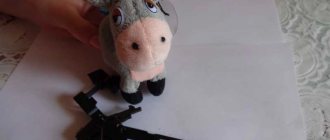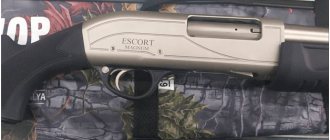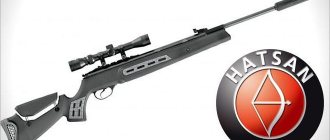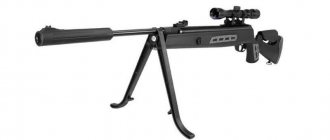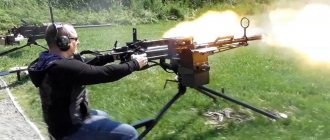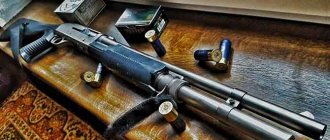Attention. As of 01.07.21, amendments to the Criminal Code of the Russian Federation (Articles 222 and 223) came into force regarding pneumatic weapons with muzzle energy over 7.5 J. If previously liability, and only administrative responsibility, was provided for carrying, transporting and shooting at borders of populated areas, then from now on criminal prosecution with quite serious sanctions is provided for the sale, as well as illegal production, alteration or repair of such samples (see No matter how tight the string is, or New “anti-pneumatic” laws). So, when reading articles written in a completely different era :)), keep in mind the newly discovered circumstances...
Spring-piston air rifles can be divided into two types - with a broken barrel and those with a fixed barrel with an under-barrel or side cocking. The latter are very similar in principle of operation, although they have some differences.
By the way, unlike a firearm, the length of a pneumatic barrel does not affect speed. For example, let's take several Hatsan supermagnums with the same parameters of compressors and gas springs. So: "Hatsan 125" - 500 mm "Hatsan 135" - 450 mm "Hatsan 130" - 415 mm "Hatsan 130 QE" - 217 mm
For all these models, the manufacturer declares the same speed - 380 m/s. Yes, in reality, with heavy bullets weighing about 0.7 grams, optimal for “supers,” this figure is about 310 m/s, but this does not change the overall picture (see “Pneumatic bullet speed”).
But first, about the general structure (keep in mind that the spring itself can be either a classic coiled spring or a so-called “gas” spring - high or low pressure).
What is “overshoot” and how to deal with it :))
The bypass is a calibrated hole between the cylinder and the “chamber” . Its diameter, along with the characteristics of the spring, is of utmost importance. Thus, rifles sold in Russia by a number of companies, mainly the Spanish “Gamo”, as well as the peculiar Turkish gamo-clones “Hatsan Striker” / “AirTact” / “Alpha” (models from 2022), are weakened to the 7.5 joules required by law namely, a narrowed bypass (in the photo below), and for the poaching, of course, illegal return of the original power (“ reinforcing the air ”), it is simply drilled out - just not with some “special drill” through the barrel!!! : for Gamo magnums on average up to 3.2 mm, for the above-listed Hatsans - up to 4 mm, or, as in the case of Diana 48/52/460, remove the washer.
Attention : the most interesting thing is that stupid drilling of the bypass in pursuit of increasing speeds after passing a certain optimal threshold (the same above-mentioned +/-3.2 mm for classic Gamov “magnums” with a 25x100 compressor) and even more so the removal of the bushing itself, on the contrary, will lead to deterioration (!) of characteristics. Well, it’s like trying to maximize the diameter of the jets on a Zhiguli carburetor in the hope of turning a VAZ into a Porsche :)). Eventually the engine will simply stop starting...
Here's the thing. If with a narrowed bypass it is intuitively clear, then with an “expanded” bypass everything is not so clear. With an optimal balance of compressor volume, mainspring force, bypass diameter and caliber, the bullet starts and moves along the barrel as the pressure increases, and its peak should be reached before it leaves the barrel - for maximum efficiency of the entire system as a whole. And with an overly expanded bypass, part of the air will be wasted: the analogy is with a firearm with a shortened barrel, where part of the powder charge designed for the standard length of the barrel bore simply does not have time to “burn out” while the bullet moves along the barrel, and a long sheaf of a useless sawn-off shotgun escaped from the barrel The flame is clearly visible at dusk.
I also note that disassembling the rifle - where possible, partial, only with the removal of the rod, or almost complete, with disassembly, is mandatory before the procedure. Well, anyone who has ever drilled anything, especially not on a professional machine, but with a hand tool, knows that the diameter of the drill itself should be slightly smaller than the intended cross-section of the hole, for example, for 3.2 mm you need to take 3- millimeter drill bit.
In other cases of illegal “strengthening of pneumatics”, as a rule, we are talking about replacing the mainspring, weakened in accordance with the requirements of Russian legislation, with a strengthened one, that is, the original one (the same “Hatsans”, except for “Strikers”, AirTacts” and “Alpha”, “Diana” "-fractures", modern "Crossmans" and "Stoegers") or a drilled piston on a solid/sealed hole (for example, old versions of "Stoegers", "Crossmans", as well as "Gamo" before 2010 onwards) - that is YOU DO NOT NEED TO DRILL ANYTHING THERE , even if you really want to :)). By the way, with PCP pneumatics the situation may not look the same, but it is a little similar: there are manipulations with the hammer springs and with the bypass.
All the details on this topic are in the “Question and Answer” section, section “How are air rifles sold in Russia weakened?”.
* * *
For spring-piston pneumatics with restored (in Russia, Ukraine, Germany, Britain, etc.) or original (in the USA, Australia, Bulgaria, etc.) power, there is a division according to this indicator into classes “magnum” and "supermagnum". This is already quite a hunting weapon (see “Air rifles for hunting”).
So, let's move on to rifles.
Air rifles with a broken barrel
About them quite briefly, since this type is widely known from the Soviet Tirov “ovens”. Although recently, even in such a conservative segment as spring-piston “fractures”, completely unique designs have also emerged. Some of them are described in the article “Unusual pneumatics: two calibers in one rifle.”
The actual loading process looks very simple: we break the barrel, the cocking rod moves the piston in the cylinder until it is cocked, held by a hook. Then we insert the bullet and return the barrel to its working position.
Pay attention to your left hand. If you neglect the retention, then if the piston is likely to fall off the hook, it is quite possible to get a broken coupling, the so-called “banana”, that is, a barrel bent upward (photo below), in especially sad cases, even with this same barrel on the forehead.
* * *
Contrary to popular belief, “perelokki” are practically no different in accuracy from rifles with a fixed barrel. A much larger role is played by the engineering elaboration of the entire structure and the quality of workmanship.
For example, the force of a heavy-duty spring may not correspond to the bypass characteristics or even the caliber of an airgun (see “Powerful Airguns: Hatsan mod 135”). The result is an unbalanced rifle with terrible accuracy and, funnily enough, reduced bullet velocity. Or, if the design of the fracture unit is unsuccessful, the bypass seal - a rubber or polymer ring on the end of the cylinder or barrel coupling (pictured below) - may become jammed or even cut off when closing.
In the above photograph, a detail is clearly visible that characterizes one of the fundamental differences in the barrel locking design of break rifles - a spring-loaded ball through a tooth. The second option is a spring-loaded bolt (in the photo below - under the barrel in the coupling) through a transverse pin or a fixed bolt.
If the sharpening angles of the bolt are unsuccessful, breaking and locking the barrel requires too much effort. Or the barrel, on the contrary, is poorly kept in a locked state. It’s these kinds of “little things” that often plague the designs of spring-piston pneumatics in the budget segment.
Air rifles with underbarrel and side cocking
Pneumatics with under-barrel cocking look very impressive, since they are quite reminiscent of “pump-action” or semi-automatic shotguns with an extended magazine.
Weihrauch HW97K
The platoon process looks like this:
The side cocking is not so striking - in the photo below, only upon careful examination can you notice the cocking lever folded along the receiver.
"Diana 52"
And this is how a platoon of such weapons is carried out (pictured is a top view):
Rifles with under-barrel/side cocking are inherently more difficult to use than breakers. And not only in design. Charging itself requires much more action and time. This is perhaps the main disadvantage of such weapons. Although it is mainly important for recreational shooting, when the count is tens, or even hundreds, of shots. When hunting, as a rule, there is only one real shot at the target - either the game will be caught, or, if it misses, it will fly away or run away. You still don’t have time to recharge.
But let's get back to the design.
Weapons with an under-barrel cocking are characterized by the presence of an additional part, in addition to the lever - the so-called “clip”, which simultaneously serves as a bypass (which in Gamo also has to be drilled out to 3.2 mm) and opens/closes access to the bullet entrance. “Clips” are different.
The photo shows the “clip” and the bullet entrance of the Spanish “Norica Quick”.
Isn't it very reminiscent of a coffin lid? In principle, it is very convenient when loading and, importantly, prevents damage to the fingers in the event of a possible breakdown of the piston (about the so-called “finger cutters” below).
And this is a “clip” from the Spanish “Gamo CFR”:
As you can see, they differ fundamentally in their operating principle. At Gamo, it does not rise, but rotates in the compressor cylinder, opening/closing the bullet inlet. Please also note that the bypass itself (also, by the way, narrowed in the Russian 7.5-joule versions) is considerably shorter than that of the Norika, which seriously reduces the so-called. “dead volume” and has a beneficial effect on the power of the shot.
However, “dead volume” is present in both cases, and the number of seals doubles compared to “fractures” - they have to be installed behind and in front of the “clip”. And they somehow let air through when fired.
The leading German company used another extremely interesting version of the clip in its entry-level model “HW 57”.
When cocked, the clip rises up using the under-barrel lever, and a bullet can be inserted into it, and then manually returned to its original position. That's it, the rifle is loaded.
And in 2022, the Turkish Stoeger released the Stoeger F40 model, traditionally based on the Gamo design:
In this case, the basis was the Gamo CF20/CF30 line. A clip of the latter is shown in the photo below, with a brass rather than plastic bullet receiver.
This scheme has a very noticeable disadvantage. If in all other cases the bypass hole and the bullet entrance, in principle, may not coincide a little, the seals “siphon”, but the air compressed by the spring will still one way or another fulfill its role as a working fluid and will quite successfully accelerate the bullet. With the "Stoeger F40" the shot is fired directly from the clip. Yes, like the Weirauch (note also, on a weak rifle), but it’s hard to say whether the Chinese comrades will be able to ensure the “German” ideal alignment of the channels. Moreover, “Gamo” at one time replaced the “CF30” line with “CFX/CFR”, including for these reasons.
Our old friend “Hatsan” went even further. In the Torpedo series of rifles (models 100, 105, 150 and 155), he used the design of a thin barrel moving in a casing.
A bit reminiscent of a longitudinally sliding bolt (like, for example, a Mosin rifle), only the direction of movement is not back and forth, but vice versa. We disengage the gold-plated handle from the rear groove of the coupling by lifting its top, then move the barrel forward, load the bullet and do everything in reverse order.
And everything would be fine, but no matter how much we take care of the seals, the movable barrel will still dangle a little in them, which will affect the accuracy. And indeed, in this indicator, the Torpedo series is inferior even to Hatsan’s breakthrough classmates - magnums like Hatsan 55 and supermagnums Hatsan 125/135.
True, recently, on the relatively new model “Hatsan Dominator 200”, the Turks have applied the “cup” principle, which has long been used on high-end rifles with underbarrel and side cocking by German and British arms companies, the most famous being “Weihrauch”, “Diana” and "AirArms". Let's move on to it.
Attention! If the article breaks off at this point, temporarily disable your ad blocker. Some of them manage to cut off the actual advertising screensavers along with the rest of the text. Moreover, they block the viewing of videos with stories about weapons, scenes of shooting or hunting.
Manufacturer's website www.hatsan.com.trActually, the first PPP that I purchased for myself. Before this I had shot with air rifles quite a lot, but this was my first time owning a piston rifle. By the way, I would like to take this opportunity to thank the participant under the nickname Seller. A man of great endurance and tact, listening to a buyer who doesn’t know what he wants and just wants a new toy (that is, me) requires a lot of patience. I got the option with a black plastic stock. The technical details are in one of the photos, you can see everything, so I won’t dwell on them in detail. Purely impressions. The “oar” is decent, a real “shaitan trumpet”. The power of the shot (bullet - diabolo - overgrown, "scarab" 0.75 grams, distance - about 2 meters) was impressive: in 1.5 cm of dry pine board the bullet was flattened so that its diameter doubled and the whole thing was blown away , holes at the exit with sawdust knocked out into small pieces, and not broken wood chips, as one might assume. A shot at a board of greater thickness (about 7 cm) showed that this bullet penetrates 2 - 2.5 cm. The shot is quiet, the muzzle also plays the role of a sound moderator (there is an extension of the chamber), it is dull and without rattling. There was diesel, but it was only expressed in a light haze from the barrel after the shot. The rifle does not have a tight trigger (by the way, it is adjustable), but it is unexpected, without warning, you have to get used to it. I can’t say anything about accuracy at the moment. From six meters (there was no greater distance in the apartment) the pile was within 1.5 centimeters. At a greater distance? What can I say - I still need to get used to double returns in order to show something decent. And so, he hit where he was aiming. “TRUGLO” is a convenient thing, aiming even in the twilight is no problem. Platooning is quite labor-intensive; it is advisable to clamp the butt in your legs. It also doesn’t close with a slight movement of the hand. But there are no backlashes, the barrel snaps into place as if welded, no swinging either up or down or to the sides. Yes, the bullets (I also used a luman 0.68 gram and the heaviest I could find on sale - a scarab 0.87 gram with a lead bullet and a brass core) fit into the barrel (from the breech, of course) very tightly, it was necessary to push through with a stick, although further they went with acceptable resistance, gently. Rifling along the entire length of the barrel, from cut to cut. I was confused by the transverse notches along the fields of the rifling along their entire length. Interestingly, this is the first time I’ve seen such a “file” in a barrel. Although they are covered with lead very quickly. There are practically no chamfers as such, only sharp edges have been removed. There was no desire to disassemble the rifle in detail, but I had to. On the next shot I noticed that the power had dropped. The bullet entered the board with a reserve, but did not pierce it. With the seller's permission, I looked inside. The butt plate is held on by one thick pin, everything is simple and intuitive, but out of habit I photographed the process, especially since the Turks were stingy with passport paper and instructions. The diesel cuff burst in two places. I realized that for pneumatics this is an ordinary thing, but it’s a hassle. Don’t be lazy to remove excess grease before use! Although there was very little of it, no Vaseline deposits. By the way, for complete disassembly and removal of the piston, you need to disconnect the barrel from the cylinder in order to remove the lever, otherwise the piston gets stuck behind it and obviously cannot be removed? Tell me who is more experienced, please. During disassembly, I also looked at the materials used. Everything is quite good and certainly no worse than theirs. Better IMHO. And even with a cracked cuff it is still more powerful. The rest can be seen in the pictures.
/////



